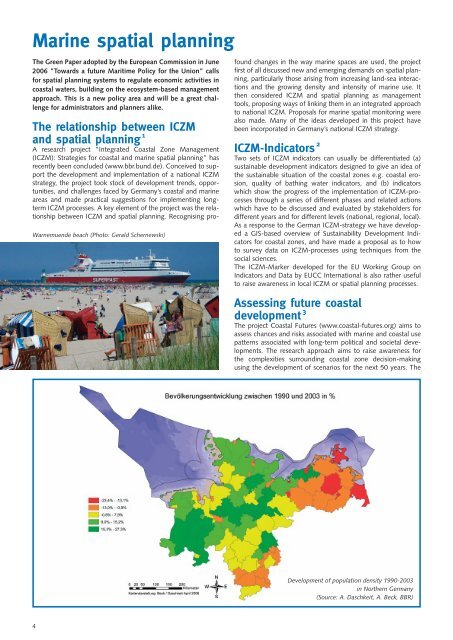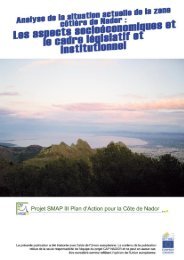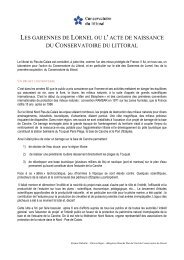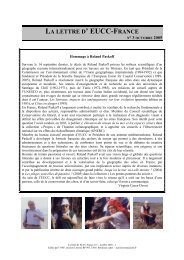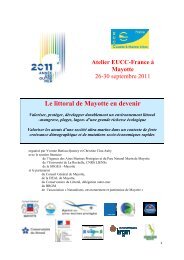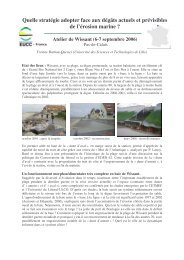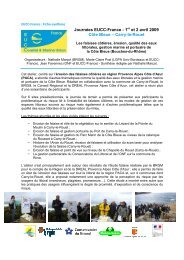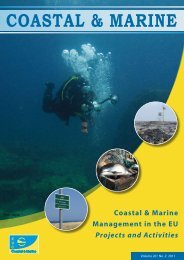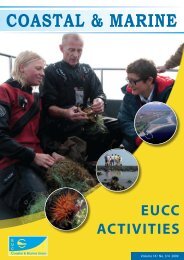COASTLINE 07-1 Coastal management in Germany - EUCC
COASTLINE 07-1 Coastal management in Germany - EUCC
COASTLINE 07-1 Coastal management in Germany - EUCC
Create successful ePaper yourself
Turn your PDF publications into a flip-book with our unique Google optimized e-Paper software.
Mar<strong>in</strong>e spatial plann<strong>in</strong>g<br />
The Green Paper adopted by the European Commission <strong>in</strong> June<br />
2006 ”Towards a future Maritime Policy for the Union” calls<br />
for spatial plann<strong>in</strong>g systems to regulate economic activities <strong>in</strong><br />
coastal waters, build<strong>in</strong>g on the ecosystem-based <strong>management</strong><br />
approach. This is a new policy area and will be a great challenge<br />
for adm<strong>in</strong>istrators and planners alike.<br />
The relationship between ICZM<br />
and spatial plann<strong>in</strong>g 1<br />
A research project ”Integrated <strong>Coastal</strong> Zone Management<br />
(ICZM): Strategies for coastal and mar<strong>in</strong>e spatial plann<strong>in</strong>g” has<br />
recently been concluded (www.bbr.bund.de). Conceived to support<br />
the development and implementation of a national ICZM<br />
strategy, the project took stock of development trends, opportunities,<br />
and challenges faced by <strong>Germany</strong>’s coastal and mar<strong>in</strong>e<br />
areas and made practical suggestions for implement<strong>in</strong>g longterm<br />
ICZM processes. A key element of the project was the relationship<br />
between ICZM and spatial plann<strong>in</strong>g. Recognis<strong>in</strong>g pro-<br />
Warnemuende beach (Photo: Gerald Schernewski)<br />
found changes <strong>in</strong> the way mar<strong>in</strong>e spaces are used, the project<br />
first of all discussed new and emerg<strong>in</strong>g demands on spatial plann<strong>in</strong>g,<br />
particularly those aris<strong>in</strong>g from <strong>in</strong>creas<strong>in</strong>g land-sea <strong>in</strong>teractions<br />
and the grow<strong>in</strong>g density and <strong>in</strong>tensity of mar<strong>in</strong>e use. It<br />
then considered ICZM and spatial plann<strong>in</strong>g as <strong>management</strong><br />
tools, propos<strong>in</strong>g ways of l<strong>in</strong>k<strong>in</strong>g them <strong>in</strong> an <strong>in</strong>tegrated approach<br />
to national ICZM. Proposals for mar<strong>in</strong>e spatial monitor<strong>in</strong>g were<br />
also made. Many of the ideas developed <strong>in</strong> this project have<br />
been <strong>in</strong>corporated <strong>in</strong> <strong>Germany</strong>’s national ICZM strategy.<br />
ICZM-Indicators 2<br />
Two sets of ICZM <strong>in</strong>dicators can usually be differentiated (a)<br />
susta<strong>in</strong>able development <strong>in</strong>dicators designed to give an idea of<br />
the susta<strong>in</strong>able situation of the coastal zones e.g. coastal erosion,<br />
quality of bath<strong>in</strong>g water <strong>in</strong>dicators, and (b) <strong>in</strong>dicators<br />
which show the progress of the implementation of ICZM-processes<br />
through a series of different phases and related actions<br />
which have to be discussed and evaluated by stakeholders for<br />
different years and for different levels (national, regional, local).<br />
As a response to the German ICZM-strategy we have developed<br />
a GIS-based overview of Susta<strong>in</strong>ability Development Indicators<br />
for coastal zones, and have made a proposal as to how<br />
to survey data on ICZM-processes us<strong>in</strong>g techniques from the<br />
social sciences.<br />
The ICZM-Marker developed for the EU Work<strong>in</strong>g Group on<br />
Indicators and Data by <strong>EUCC</strong> International is also rather useful<br />
to raise awareness <strong>in</strong> local ICZM or spatial plann<strong>in</strong>g processes.<br />
Assess<strong>in</strong>g future coastal<br />
development 3<br />
The project <strong>Coastal</strong> Futures (www.coastal-futures.org) aims to<br />
assess chances and risks associated with mar<strong>in</strong>e and coastal use<br />
patterns associated with long-term political and societal developments.<br />
The research approach aims to raise awareness for<br />
the complexities surround<strong>in</strong>g coastal zone decision-mak<strong>in</strong>g<br />
us<strong>in</strong>g the development of scenarios for the next 50 years. The<br />
Development of population density 1990-2003<br />
<strong>in</strong> Northern <strong>Germany</strong><br />
(Source: A. Daschkeit, A. Beck, BBR)<br />
4


